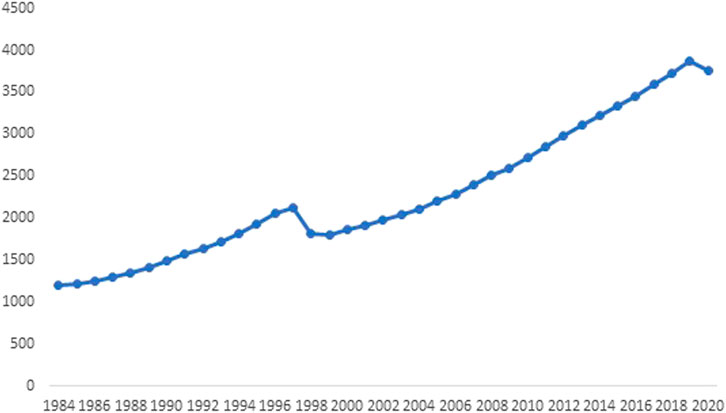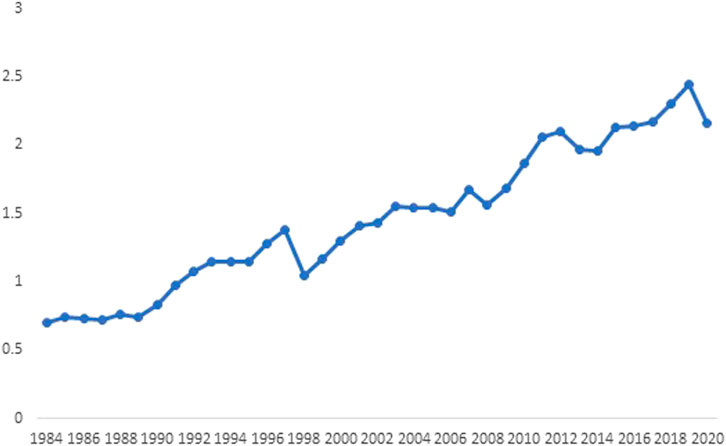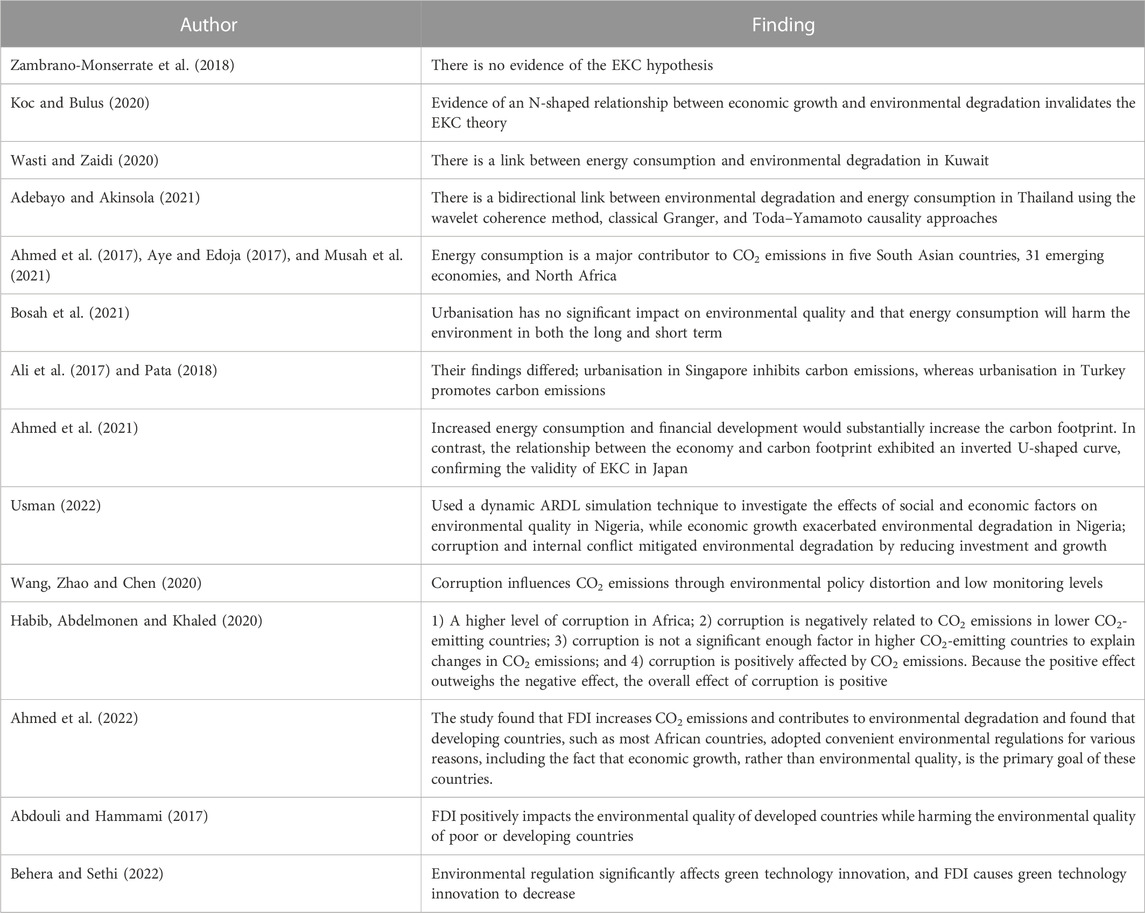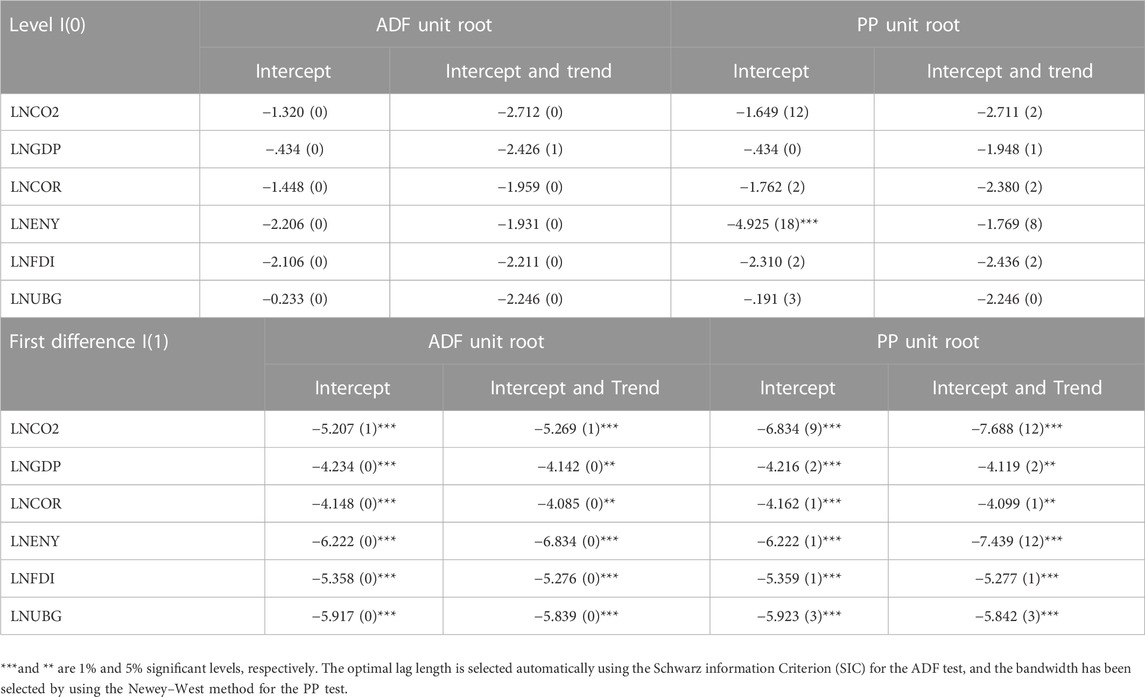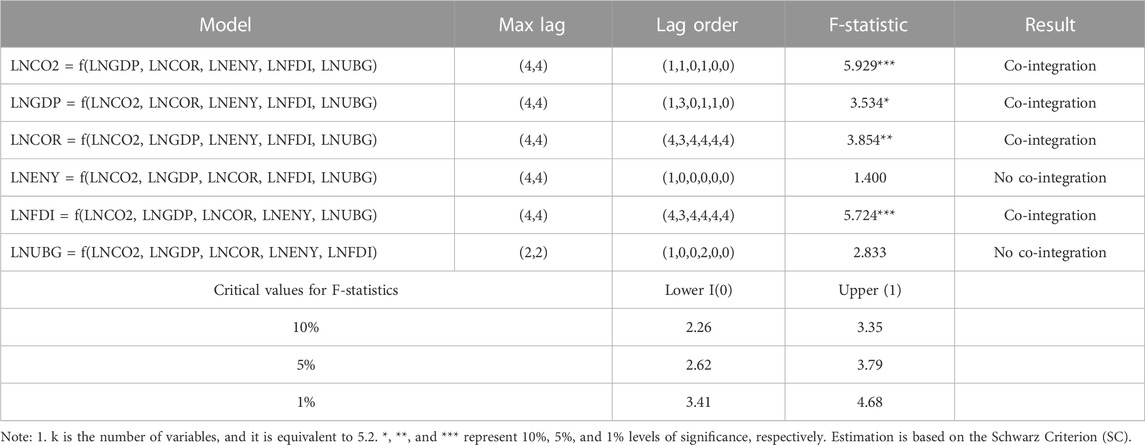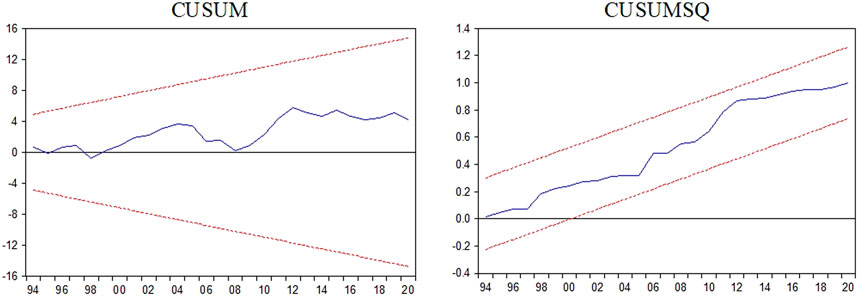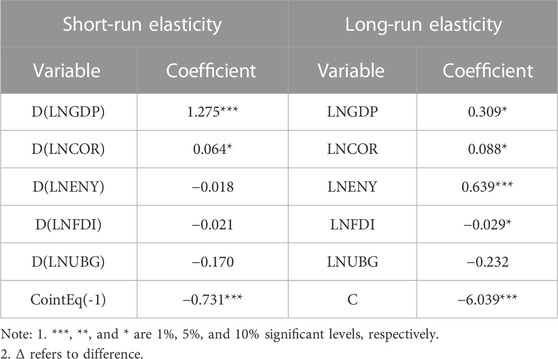- 1Faculty of Economics, Universitas Negeri Semarang, Semarang, Indonesia
- 2Faculty of Business and Management, Universiti Teknologi MARA, Shah Alam, Malaysia
- 3Faculty of Economics and Business, Universitas Negeri Malang, Malang, Indonesia
- 4Institute for Big Data Analytics and Artificial Intelligence, Universiti Teknologi MARA, Shah Alam, Malaysia
- 5Centre for Economic Development and Policy, Universiti Malaysia Sabah, Kota Kinabalu, Malaysia
- 6Institute for Research on Socio Economic Policy, Universiti Teknologi MARA, Shah Alam, Malaysia
- 7Faculty of Business and Communication, Universiti Malaysia Perlis, Arau, Malaysia
The alarming trend of CO2 emissions in Indonesia merits a reinvestigation into the determinants in a bid to conserve the environment. In the literature, in Indonesia, three potential determinants, namely, energy, foreign direct investment, and corruption, have been identified to harm the environment. However, their effects are still undetermined. Thus, this study aims to examine the relationships between corruption (COR), energy use (ENY), foreign direct investment (FDI), and CO2 emissions in Indonesia. The autoregressive distributed lag (ARDL) approach was used to analyse data for 36 years, from 1984 to 2020. The results reveal that corruption contributes to greater environmental degradation in the short run, while foreign direct investment does not. However, in the long run, corruption and energy use can positively affect environmental degradation, but foreign direct investment can reduce environmental degradation in Indonesia. This study also found two other factors, namely, economic growth and urbanisation, which can affect the environment with mixed findings. These findings are indispensable for policy formulation in Indonesia as Indonesia is a rapidly developing country that depends on good environmental quality to ensure future growth and sustainable development.
1 Introduction
In the last few decades, developing countries have progressed rapidly. They have transformed from agriculture to industrialisation, boosting economic growth and improving people’s living standards. In Indonesia, the change of power from the old order regime to the new order has transformed Indonesia’s economic policy. Since the 1980s, Indonesia has sought to boost economic growth, leading to a higher energy use and rapid urbanisation. Moreover, the country has successfully attracted higher foreign direct investment (FDI) through numerous government incentives and tax reforms. Figure 1 shows the growth of Indonesia’s gross domestic product (per capita 2005) from 1984 to 2020. The value of GDP per capita in 1984 stood at 1,204 US dollars, and it tripled in 2020 to 3,757 US dollars. This condition shows a significant increase in the prosperity and welfare of the people. The rapid growth in the industrial and manufacturing sectors that contributed towards the country’s GDP, however, has caused detrimental effects on the environmental quality in Indonesia (Pujiati et al., 2020).
The development strategies that Indonesia implemented to accelerate the economic performance were supported by population growth and the improvement of urban communities. This, however, has raised an important issue: environmental pollution (Sehrawa et al., 2015). The impact of unmoderated development and technological progress has pushed the country to face sustainable development challenges, such as environmental degradation, climate change, and exploitation of natural resources (Koshta et al., 2021). Rahman (2020) stated that economic growth requires additional production from an industry, and the additional energy consumption is unavoidable, which drives carbon emissions. Alam (2022) argued that the requirements for an increased economic growth undermined the environmental quality in developing countries, leaving a long-lasting impact on development and industrialisation. Although the Indonesian government has introduced sustainable development plans, the level of carbon emission still increases as the country continues to rely on dirty energies, such as coal and fossil fuels, to keep up with the increasing demand.
Figure 2 shows an increase of 2.09% in CO2 emissions from 1984 to 2020. The value of CO2 emissions in 1984 was only 0.7 metrics per capita and reached 2.16 metrics per capita in 2020. Population growth and urbanisation can increase CO2 emissions in developing countries (Ansari et al., 2019) as more people are attracted to urban areas because of their development (Pujiati et al., 2019). Due to urbanisation, the country has developed better infrastructure that attracts more foreign investors to run their businesses there. However, in the presence of foreign investment, environmental degradation may either increase or decrease.
Danmaraya and Danlami (2021) stated that the driving factor for CO2 emissions is foreign direct investment, which has different impacts on environmental quality through composition, engineering, and scale effects. The composition effect concludes that FDI can increase or decrease pollution by changing the economic patterns. However, the effect of scale states that FDI harms the environment by increasing the size of the country’s economy. Meanwhile, the engineering effect states that foreign companies can adopt more environmental friendly technologies and improve the environment by reducing emissions. Munir and Ameer (2019) stated that FDI brings inappropriate technology, which is the primary source of pollution. Capital inflows into a country can have a major impact on the environment, depending on the type of technology used and rules and regulations on environmental protection (Panait et al., 2022). Many researchers have found that FDI positively affects CO2 emissions in lower-middle countries (Hassaballa, 2014; Paramati et al., 2016; Danlami et al., 2019). However, the findings of studies that investigated the relationship between FDI and environmental degradation in Indonesia remain inconclusive. In addition, good governance can also affect the environmental quality.
Sustainable development must be supported by good governance. In pursuing long-term sustainable growth, state institutions should adopt efficient practices and implement ethical and responsible actions to achieve long-term strategic goals. Community supervision is essential to avoid unethical and irresponsible actions. Corruption is a global problem with power that can affect all countries and all sectors of activity (Sekrafi and Sghaier, 2017). A high level of corruption indicates incompetent governance. The issue of corruption and environmental degradation in Indonesia has become a major concern in recent years. The prevalent corruption has resulted in the high exploitation of natural resources and massive environmental damage. The use of dirty energy may increase in the presence of corruption. Muslihudin et al. (2018) explained that there are three situations when corruption can happen and thus harm the environment: 1) when licencing from entrepreneurs to regional heads, 2) when granting environmental impact analysis licences, and 3) when imposing fees on entrepreneurs that can cause higher costs. Indonesia’s Corruption Perceptions Index (CPI) in 1984 was 1.00 and increased to 3.00 in 2020, indicating greater corruption and thus merits serious attention. Ganda (2020) found that the corrupt behaviour using two indices, namely, the corruption index and corruption rankings, has worsened environmental sustainability in 16 countries in Southern Africa. Cole and Fredriksson (2009) found that countries with weak environmental institutions will attract more polluting industries that encourage environmental damage.
Due to the mixed findings on the impact of energy use, FDI, and corruption on the environment in other countries, it is still important to reinvestigate the effects of energy use, foreign direct investment, and corruption on the environment in Indonesia from 1984 to 2020. The structure of this paper consists of Section 1: Introduction, Section 2: Literature review, Section 3: Methodology, Section 4: Results and discussion, and Section 5: Conclusions and policy implications.
2 Literature review
On a theoretical level, Antweiler et al.’s (2004) model indicates that, through specialisation and exchanges, rich countries concerned about the quality of their environment should relocate polluting activities to developing countries, which are generally characterised by less stringent environmental regulations. Numerous researchers from various countries or regions have discovered a link between economic growth and environmental degradation. The results vary depending on the sample size and the time period studied (Koengkan et al., 2019a; Chishti et al., 2021; Qin et al., 2021). Many researchers have used the environmental Kuznets curve (EKC) hypothesis to investigate the relationship between economic growth and environmental quality (Yilanci and Pata, 2020). The theory’s validity has been demonstrated in several countries, including the United States (Atasoy, 2017), Pakistan (Rehman et al., 2021a), Malaysia (Nurgazina et al., 2021), China (Pata and Caglar, 2021), and the OECD (Cao et al., 2022). On the other hand, some studies have been unable to establish a link between economic growth and environmental degradation. For example, Zambrano-Monserrate et al. (2018) investigated the Peruvian nexus and discovered that the findings do not support the EKC hypothesis. Another study on South Korea by Koc and Bulus (2020) found evidence of an N-shaped relationship between economic growth and environmental degradation, invalidating the EKC theory.
Some studies have investigated the relationship between energy consumption and environmental degradation, particularly CO2 emissions (Khan, Hou and Le, 2021). Wasti and Zaidi (2020) found a link between energy consumption and environmental degradation in Kuwait. Adebayo and Akinsola (2021) revealed a bidirectional link between environmental degradation and energy consumption in Thailand using the wavelet coherence method, classical Granger, and Toda–Yamamoto causality approaches. In addition, Ahmed et al. (2017), Aye and Edoja (2017), and Musah et al. (2021) identified energy consumption as a major contributor to CO2 emissions in five South Asian countries, 31 emerging economies, and North Africa, respectively.
Because the ARDL model has produced significant results in other fields, many scholars have applied it to the study of environmental economics to investigate the long-term and short-term relationships between related variables. Bosah et al. (2021) examined the panel data from 15 countries on energy consumption, economic growth, urbanisation, and carbon emissions. The findings indicated that urbanisation has no significant impact on environmental quality and that energy consumption will harm the environment in the long and short run. Ali et al. (2017) and Pata (2018) investigated the relationship between urbanisation and CO2 emissions in Singapore and Turkey. However, their findings are inconsistent as there is a negative relationship between urbanisation and CO2 emissions in Singapore, and there is a positive relationship in Turkey. With Japanese research subjects, Ahmed et al. (2021) examined the impact of globalisation, economic growth, and financial development on a carbon footprint. The findings revealed that an increased energy consumption and financial development would substantially increase the carbon footprint. In contrast, the relationship between the economy and carbon footprint exhibited an inverted U-shaped curve, confirming the validity of EKC in Japan.
The existing literature on the relationship between corruption and environmental sustainability is active (Ganda, 2020; Wang, Zhao and Chen, 2020; Usman, 2022). According to popular beliefs, corruption can, directly and indirectly, contribute to environmental degradation (Wang, Zhao, and Chen 2020). Usman (2022), for example, used a dynamic ARDL simulation technique to investigate the effects of social and economic factors on the environmental quality in Nigeria. Although economic growth exacerbated environmental degradation in Nigeria, corruption and internal conflict mitigated environmental degradation by reducing the investment and growth. Wang, Zhao, and Chen (2020) used the system GMM on provincial panel data in China’s industry from 2005 to 2015 to establish that corruption influences CO2 emissions through environmental policy distortions and low monitoring levels.
Furthermore, Habib, Abdelmonen, and Khaled (2020) investigated how corruption affects CO2 emissions and economic growth in Africa using a panel quantile regression method. The findings were as follows: 1) a higher level of corruption in Africa; 2) corruption is negatively related to CO2 emissions in lower CO2-emitting countries; 3) corruption is not a significant enough factor in higher CO2-emitting countries to explain changes in CO2 emissions; and 4) corruption is positively affected by CO2 emissions. Because the positive effect outweighs the negative effect, the overall effect of corruption is positive.
Regarding the relationship between FDI and CO2 emissions, Ahmed et al. (2022) found that developing countries, such as most African countries, adopted convenient environmental regulations for a variety of reasons, including the fact that economic growth, rather than environmental quality, is the primary goal of these countries. The study found that FDI increases CO2 emissions and contributes to environmental degradation. This assertion was supported by the study of Abdouli and Hammami (2017) and Pata et al. (2022), which found that FDI positively impacts the environmental quality of developed countries while having a negative impact on the environmental quality of poor or developing countries. Using green technology, FDI, and environmental regulation, Behera and Sethi (2022) discovered that environmental regulation significantly affects green technology innovation and that FDI causes green technology innovation to decrease.
Several gaps have been found in previous studies. First, it is hard to find studies focussing on the impact of foreign investment, energy used, and corruption in Indonesia. Thus, this research’s findings could contribute to the body of knowledge. In addition, this research uses the most recent sample data and sophisticated techniques to provide some insight into the robustness of the findings. The summary of empirical studies as discussed in this section can be view in Table 1.
3 Methodology
The IPAT model provides an equation that articulates the idea of the environmental impact (I), which is dependent on three factors, namely, population (P), affluence (A), and technology (T). The model can be written as follows:
According to the model, environmental degradation increases as the affluence or wealth of a nation increases. Countries with rapid economic development will usually focus on boosting their economic activity, which leads to higher environmental degradation. Moreover, population growth can also contribute to harming the environment. This might be due to the higher use of non-renewable resources, such as oil and coal. Boosting a country’s economy usually entails using low-cost technologies, which subsequently results in a lower quality of the environment.
Previous researchers, such as Mahmood et al. (2020), used CO2 emissions as a proxy for environmental degradation, population growth as a proxy for population, GDP as a proxy for affluence, and energy use as a proxy for technology. Inspired by this model, this research reintroduces the model by including other important variables. The general functional form of the environmental quality model for Indonesia is derived as follows:
where CO2t represents the environmental quality, GDPt represents the economic growth, CORt represents corruption, ENYt represents the energy used, FDIt represents foreign direct investment inflows, and UBGt represents the urbanisation growth.
The variables in Eq. 3 are transformed into log-linear forms (LN). The log version of the variables will indicate the short-run and long-run elasticity. According to Shahbaz et al. (2013), the log version of the tested variables can produce a consistent and reliable estimation. The log version of the model derived from Eq. 2 can be seen as follows:
A higher economic development (LNGDP) is expected to increase environmental degradation (LNCO2) or exhibit positive signs, especially in developing countries. This expected sign can be seen in past studies conducted in Malaysia, such as Ridzuan et al. (2018) and Ridzuan et al. (2019). Next, LNCOR is expected to have either a positive or negative relationship with LNCO2, depending on the government rules and integrity when managing their country. Then, LNFDI is expected to have either a positive or negative link with LNCO2 for Indonesia. Therefore, the presence of the pollution haven hypothesis is validated if the expected sign between LNFDI and LNCO2 is positive. This outcome can be seen from previous studies such as Gorus and Aslan (2019) and Caglar (2020). In contrast, if the sign is negative, it validates the existence of the pollution halo hypothesis, which was also proven by Rafindadi et al. (2018) and Balsalobre-Lorente et al. (2019a). The pollution haven hypothesis, addressed by Terzi and Pata (2019) and Pata and Amit, (2021), is a situation where foreign investors decide to invest more money into a country with less stringent environmental policies. The validation of the pollution halo hypothesis, on the other hand, is the result of the engagement of foreign companies to use better management practices and advanced technologies that result in a clean environment in the host countries. Similar to LNGDP, energy used also exhibits a positive relationship with LNCO2. Higher energy generated from the combustion of fossil fuels will lead to a higher release of carbon emissions in the country. Regarding urbanisation, some studies suggest the increased population caused by urbanisation triggers an intensive urban economic activity, which leads to an increased demand for energy and carbon emissions (Ali et al., 2019). However, some studies suggest urbanisation brings about economies of scale and improves public infrastructure, reducing carbon emissions (Lin and Li, 2020). No consistent conclusions have been reached.
The ARDL model considers each of the variables in turn as the dependent variables based on the unrestricted error correction model (UECM) are stated as follows.
where ∆ is the first difference operator and ut is the white-noise disturbance term. Residuals for the UECM should be serially uncorrelated, and the model should be stable. This validation can be addressed with a series of diagnostic tests shown in the analysis section. The final version of the model represented in Eq. 4–Eq. 8 previously can also be viewed as an ARDL of order (a b c d e f g h i). The model indicates that environmental degradation (LNCO2) can be influenced and explained by its past values. Hence, it involves other disturbances or shocks. From the estimation of UECM, the long-run elasticity is the coefficient of the one-lagged explanatory variable (multiplied by a negative sign) divided by the coefficient of the one-lagged dependent variable.
The coefficients of the first differenced variables captured the short-run effects. The null hypothesis of no co-integration in the long-run relationship is defined by
H0: θ0=θ1=θ2=θ3=θ4=θ5=0 (there is no long-run relationship) is tested against the alternative of
H1: θ0≠θ1≠θ2≠ θ3≠θ4≠θ5≠0 (a long-run relationship exists), employing the familiar F-test, suppose the computed F-statistic is less than the lower-bound critical value. In that case, we do not reject the null hypothesis of no co-integration. However, suppose the computed F-statistics is greater than the upper-bound critical value of at least the 10% significant level. In that case, we reject the null hypothesis of no co-integration.
In this work, we aimed to test the dynamic linkages between the potential indicators for Indonesia’s environmental quality, where the previous literature using panel data analysis has presented mixed and ambiguous evidence for each nation (Hossain, 2011). To get around some of the issues with panel data analysis, we used the time series analysis in our study. Furthermore, to deliver reliable results, country-specific analyses like this study are required (Chandran et al., 2010). In addition, our study strongly emphasises the causal links between FDI and CO2 emissions, which gives us less insight into the pollution haven theory. According to the previous literature, FDI may increase global CO2 emissions if environmental regulations are loosened in developing nations (Pao & Tsai, 2011).
This study uses the annual data ranging from 1984 up to 2020 (36 years) as a sample period. A summary of the data and its sources is shown in Table 2.
4 Result and discussion
The stationarity of the data needs to be tested to identify the right co-integration analysis for time series data. The stationarity analysis is performed by using ADF and PP unit roots. The outcomes can be viewed in Table 3. Based on the ADF unit root, it is found that all variables are not stationary at any level. However, all variables are found to be stationary at a 1 or 5% significant level at the first difference. We proceed to the PP unit root test to reconfirm the stationarity of each variable. The PP unit root is more powerful than the ADF unit root. Overall, we found that LNENY is stationary at the 1% significant level, while the remaining variables are not significant. However, as we proceed to the first difference, all variables are found to be significant either at a 1 or 5% significant level. The mix stationarity outcome fulfils the condition for ARDL testing for the model proposed in this study.
In examining the long-run relationship between CO2 and its determinants, we proceed to the bounds-testing approach for all possible models, and the results are reported in Table 4. The computed F-statistics for CO2, GDP, COR, and FDI equations suggest the rejection of the null hypothesis of no co-integration. The F statistic from this model is significant between the 1% and 10% significant level. However, the null hypothesis is not rejected for other equations. We can proceed to the long-run and short-run estimations based on the main model, and the following analysis will be solely performed on this model.
Before proceeding to the primary outcomes, we must ensure that the model we run has passed all diagnostic tests. Among the diagnostic tests we performed are serial correlation, functional form, normality, heteroscedasticity, and stability model consisting of CUSUM and CUSUMSQ tests. Based on Table 5, it is confirmed that the carbon emissions model that we focus on in this study has passed all the diagnostic tests, as shown in Table 4. The probability value for the first four tests is more than the 10% significance level, thus confirming that the model is free from serial correlation problems, is functioning well, is normally distributed, and has no heteroscedasticity problem.
We also performed CUSUM and CUSUMSQ tests to ensure the stability of the model. Based on Figure 3, the blue line is in between the two red lines, thus confirming that the model is reliable.
Table 6 shows the main analysis based on short- and long-run elasticities. As for the short-run outcomes, we found out that both LNGDP and LNCOR have a positive association with environmental degradation in Indonesia. Statistically, 1% increase in LNGDP and LNCOR leads to 1.28% and 0.01% increase in carbon emissions releases. Rapid development in the country causes more pollution than governance. Meanwhile, other variables such as LNENY, LNFDI, and LNUBG are not significant at any level, thus not affecting environmental degradation in the short run. The estimated lagged ECT in ARDL regression for this model appears to be negative and statistically significant. Based on the ECT value, the adjustment speed was obtained at 0.731. For instance, this value indicated that more than 73% of adjustments were completed within less than a year, and all the variables converge; thus, the outcome for long-run elasticities will provide a meaningful input for the policymakers.
The long-run elasticities are explained as follows: the relationship between economic growth and CO2 emissions is positive and significant at 10%. Keeping other things the same, a 1% increase in economic growth increases CO2 emissions by 0.31%. This outcome is similar to the previous research performed by Shahbaz et al. (2013) and Sugiawan and Managi (2016). Our empirical findings indicate that economic growth is the second largest contributor to CO2 emissions in the case of Indonesia. Our empirical exercise indicates that energy use (LNENY) is the largest contributor to carbon emission in the case of Indonesia. A 1% increase in LNENY leads to a 0.64% increase in carbon emissions. Indonesia’s economy still relies heavily on coal as a cheaper energy source for economic development; however, it has degraded the climate quality (Ridzuan et al., 2021; Ahmed F. et al., 2022; Hongqiao et al., 2022). Systemic corruption in Indonesia has a long-term worsening effect on environmental degradation. Statistically, a 1% increase in LNCOR led to an increase of 0.09% in carbon emission. This finding supports the previous findings by Akali et al. (2021), where corruption positively affects environmental pollution. The rise of corruption may lead to an extension of economic activities by short-circuiting the bureaucratic process, which triggers more resource utilisation and leads to environmental destruction.
Furthermore, the weakening to implement environmental regulations because of corruption is one of the main reasons for lacking environmental targets (Balsalobre-Lorente et al., 2019b). The corruption level could hinder the country’s progress towards achieving environmental sustainability. The only favoured outcome from this model is LNFDI. The results reveal that LNFDI has a negative relationship with LNCO2. Technically, a 1% increase in LNFDI decreases LNCO2 emissions by 0.03%. This outcome validates the halo effect hypothesis, where a higher level of foreign direct investment focussing on green and clean technology helps the nation curb industrial emissions. This result is in line with the studies performed by Rafindadi et al. (2018).
5 Conclusion and policy implications
This study aims to analyse the dynamic linkages between GDP, corruption, energy use, FDI, and urbanisation on CO2 emissions in Indonesia. This study uses an autoregressive distributed lag (ARDL) to measure the short-run and long-run elasticities among the tested variables. Based on the short run, the variables that affect CO2 emissions in Indonesia are GDP and corruption. GDP and corruption have a positive effect on CO2 emissions. Energy use, foreign investment, and urbanisation have no effect on CO2 emissions. In the long run, the variables that affect CO2 emissions are GDP, corruption, energy use, and FDI. Urbanisation, in the long run, however, does not affect CO2 emissions. GDP, corruption, and energy use have a positive effect, while FDI harms CO2 emissions in Indonesia.
The findings of this study are important for policy implications. Economic development in Indonesia can lead to environmental degradation. This problem is common in most countries as pursuing sustainable development is difficult. However, it is possible if the government is serious about achieving the sustainability that the United Nations has promoted. Policymakers must ensure that new development projects implemented by developers must follow environmental regulations, or they have to consider green development in their projects. The imposition of environmental taxes is ineffective as developers can still harm the environment if willing to pay higher taxes.
The heavy reliance on dirty energies should come to an end. Policymakers must emphasise exploring clean and renewable energies such as solar, biomass, and tidal energies to generate electricity, thus reducing the consumption of dirty energies. The government needs to continue to create awareness in the public of how to use energy efficiently and organise a sustainable development campaign to reduce CO2 emission levels in Indonesia.
Corruption is a serious problem in Indonesia and harms environmental quality. The government must ensure that integrity and professionalism are top priorities for government officials. Those who have the power to approve any projects should be monitored closely by government agencies to avoid any wrongdoings, such as corruption.
Lastly, the Indonesian government should provide various incentives to foreign companies in order to encourage them to use green technology. However, those who harm the environment may need to pay taxes.
This study has its limitations. For example, it uses a limited number of independent variables to explain CO2 emissions in Indonesia. Therefore, future research needs to consider other potential variables affecting CO2 emissions, such as education (Antweiler et al., 2004) and local culture.
Data availability statement
The raw data supporting the conclusion of this article will be made available by the authors, without undue reservation.
Author contributions
AR and AP worked together on data collection and statistical analysis, and contributed to the writing of the manuscript. The rest of the authors helped refine each section of the manuscript. All authors have read and agreed to the published version of the manuscript.
Funding
This research project is a collaboration between two universities: Universiti Teknologi MARA, Malaysia, and Universitas Negeri Semarang, Indonesia, under the Strategic Partnership Research grant. The authors wish to extend their gratitude to Universiti Teknologi MARA (100-RMC5/3/SRPINT(010/2022) and Universitas Negeri Semarang (B/2453/UN37.1.7/KS/2022) for financing this research project.
Conflict of interest
The authors declare that the research was conducted in the absence of any commercial or financial relationships that could be construed as a potential conflict of interest.
Publisher’s note
All claims expressed in this article are solely those of the authors and do not necessarily represent those of their affiliated organizations, or those of the publisher, the editors, and the reviewers. Any product that may be evaluated in this article, or claim that may be made by its manufacturer, is not guaranteed or endorsed by the publisher.
References
Abdouli, M., and Hammami, S. (2017). Economic growth, FDI inflows and their impact on the environment: An empirical study for the MENA countries. Qual. Quantity 51, 121–146. doi:10.1007/s11135-015-0298-6
Adebayo, T. S., and Akinsola, G. D. (2021). Investigating the causal linkage among economic growth, energy consumption and CO2 emissions in Thailand: An application of the wavelet coherence approach. Int. J. Renew. Energy Dev. 10 (1), 17–26. doi:10.14710/ijred.2021.32233
Ahmed, F., Ali, I., Kousar, S., and Ahmed, S. (2022). The environmental impact of industrialization and foreign direct investment: Empirical evidence from asia-pacific region. Environ. Sci. Pollut. Res. 29, 29778–29792. doi:10.1007/s11356-021-17560-w
Ahmed, K., Rehman, M. U., and Ozturk, I. (2017). What drives carbon dioxide emissions in the long-run? Evidence from selected South Asian countries. Renew. Sustain. Energy Rev. 70, 1142–1153. doi:10.1016/j.rser.2016.12.018
Ahmed, Z., Can, M., Sinha, A., Ahmad, M., Alvarado, R., and Rjoub, H. (2022). Investigating the role of economic complexity in sustainable development and environmental sustainability. Int. J. Sustain. Devel-404 opment World Ecol. 29 (8), 1–13. doi:10.1080/13504509.2022.2097330
Ahmed, Z., Zhang, B., and Cary, M. (2021). Linking economic globalization, economic growth, financial development, and ecological footprint: Evidence from symmetric and asymmetric ARDL. Ecol. Indic. 121, 107060. doi:10.1016/j.ecolind.2020.107060
Akali, G., Erdogan, S., and Sarkodie, S. A. (2021). Do dependence on fossil fuels and corruption spur ecological footprint. Environ. Impact Assess. Rev. 90, 106641. doi:10.1016/j.eiar.2021.106641
Alam, M. S. (2022). Is trade, energy consumption and economic growth threat to environmental quality in Bahrain–evidence from VECM and ARDL bound test approach. Int. J. Emerg. Serv. 11 (3). ahead-of-print No. ahead-of-print. doi:10.1108/IJES-12-2021-0084
Ali, H. S., Abdul-Rahim, A. S., and Ribadu, M. B. (2017). Urbanization and carbon dioxide emissions in Singapore: Evidence from the ARDL approach. Environ. Sci. Pollut. Res. 24, 1967–1974. doi:10.1007/s11356-016-7935-z
Ali, R., Bakhsh, K., and Yasin, M. A. (2019). Impact of urbanization on CO2 emissions in emerging economy: Evidence from Pakistan. Sustain. Cities Soc. 48, 101553. doi:10.1016/j.scs.2019.101553
Ansari, M. A., Haider, S., and Khan, N. A. (2019). Does trade openness affects global carbon dioxide emissions: Evidence from the top CO2 emitters. Manag. Environ. Qual. 31 (1), 32–53. doi:10.1108/meq-12-2018-0205
Antweiler, W., Copeland, B. R., and Taylor, M. S. (2004). Is free trade good for the environment. Am. Econ. Rev. 91 (4), 877–908. doi:10.1257/aer.91.4.877
Atasoy, B. S. (2017). Testing the environmental kuznets curve hypothesis across the U.S.: Evidence from panel mean group estimators. Renew. Sustain. Energy Rev. 77, 731–747. doi:10.1016/j.rser.2017.04.050
Aye, G. C., and Edoja, P. E. (2017). Effect of economic growth on CO2 emission in developing countries: Evidence from a dynamic panel threshold model. Cogent Econ. Finance 5 (1), 1379239. doi:10.1080/23322039.2017.1379239
Balsalobre-Lorente, D., Gokmenoglu, K. K., Taspinar, N., and Cantos-Cantos, J. M. (2019a). An approach to the pollution haven and pollution halo hypotheses in MINT countries. Environ. Sci. Pollut. Res. 26, 23010–23026. doi:10.1007/s11356-019-05446-x
Balsalobre-Lorente, D., Shahbaz, M., Jabbour, C. J. C., and Driha, O. M. (2019b). “The role of energy innovation and corruption in carbon emissions: Evidence based on the EKC hypothesis,” in Energy and environmental strategies in the era of globalization (Cham, Switzerland: Springer), 271–304.
Behera, P., and Sethi, N. (2022). Nexus between environment regulation, FDI, and green technology innovation in OECD countries. Environ. Sci. Pollut. Res. 29, 52940–52953. doi:10.1007/s11356-022-19458-7
Bosah, C. P., Li, S., Ampofo, G. K. M., and Liu, K. (2021). Dynamic nexus between energy consumption, economic growth, and urbanization with carbon emission: Evidence from panel PMG-ARDL estimation. Environ. Sci. Pollut. Res. 2843, 61201–61212. doi:10.1007/s11356-021-14943-x
Caglar, A. E . (2020). The importance of renewable energy consumption and FDI inflows in reducing environmental degradation: Bootstrap ARDL bound test in selected 9 countries. J. Clean. Prod. 264, 121663. doi:10.1016/j.jclepro.2020.121663
Cao, H., Khan, M. K., Rehman, A., Dagar, V., Oryani, B., and Tanveer, A. (2022). Impact of globalization, institutional quality, economic growth, electricity and renewable energy consumption on carbon dioxide emission in OECD countries. Environ. Sci. Pollut. Res. 29 (16), 24191–24202. doi:10.1007/s11356-021-17076-3
Chandran, V. G. R., Sharma, S., and Madhavan, K. (2010). Electricity consumption-growth nexus: The case of Malaysia. Energy Policy 38, 606–612. doi:10.1016/j.enpol.2009.10.013
Chishti, M. Z., Ahmed, Z., Murshed, M., Namkambe, H. H., and Ulucak, R. (2021). The asymmetric associations between foreign direct investment inflows, terrorism, CO2 emissions, and economic growth: A tale of two shocks. Environ. Sci. Pollut. Res. 28, 69253–69271. doi:10.1007/s11356-021-15188-4
Cole, M. A., and Fredriksson, P. G. (2009). Mismeasuring biological diversity: Response to hoffmann and hoffmann (2008). Ecol. Econ. 68 (4), 925–928. doi:10.1016/j.ecolecon.2008.10.015
Danlami, A. H., Aliyu, S., and Danmaraya, I. A. (2019). Energy production, carbon emissions and economic growth in lower-middle income countries. Int. J. Soc. Econ. 46 (1), 97–115. doi:10.1108/IJSE-07-2017-0274
Danmaraya, I. A., and Danlami, A. H. (2021). Impact of hydropower consumption, foreign direct investment and manufacturing performance on Co2 emissions in the ASEAN-4 countries. Int. J. Energy Sect. Manag. 16 (5), 856–875. doi:10.1108/IJESM-06-2021-0019
Ganda, F. (2020). The influence of corruption on environmental sustainability in the developing economies of Southern Africa. Heliyon 6 (7), 043877–e4416. doi:10.1016/j.heliyon.2020.e04387
Gorus, M. S., and Aslan, M. (2019). Impacts of economic indicators on environmental degradation: Evidence from MENA countries. Renew. Sustain. Energy Rev. 103, 259–268. doi:10.1016/j.rser.2018.12.042
Habib, S., Abdelmonen, S., and Khaled, M. (2020). The effect of corruption on the environmental quality in african countries: A panel quantile regression analysis. J. Knowl. Econ. 11, 788–804. doi:10.1007/s13132-018-0571-8
Hassaballa, H. (2014). Testing for granger causality between energy use and foreign direct investment inflows in developing countries. Renew. Sustain. Energy Rev. 31, 417–426. doi:10.1016/j.rser.2013.12.011
Hongqiao, H., Xinjun, W., Ahmad, M., and Zhonghua, L. (2022). Does innovation in environmental technologies curb CO2 emissions? Evidence from advanced time series techniques. Front. Environ. Sci. 10, 407. doi:10.3389/FENVS.2022.930521
Hossain, M. S. (2011). Panel estimation for CO2 emissions, energy consumption, economic growth, trade openness and urbanization of newly industrialized countries. Energy Policy 39, 6991–6999. doi:10.1016/j.enpol.2011.07.042
Khan, I., Hou, F., and Le, H. P. (2021). The impact of natural resources, energy consumption, and population growth on environmental quality: Fresh evidence from the United States of America. Sci. Total Environ. 754, 142222. doi:10.1016/j.scitotenv.2020.142222
Koc, S., and Bulus, G. C. (2020). Testing validity of the EKC hypothesis in South Korea: Role of renewable energy and trade openness. Environ. Sci. Pollut. Res. 27 (23), 29043–29054. doi:10.1007/s11356-020-09172-7
Koengkan, M., Losekann, L. D., and Fuinhas, J. A. (2019a). The relationship between economic growth, consumption of energy, and environmental degradation: Renewed evidence from Andean community nations. Environ. Syst. Decis. 39 (1), 95–107. doi:10.1007/s10669-018-9698-1
Koshta, N., Bashir, H. A., and Samad, T. A. (2021). Foreign trade, financial development, agriculture, energy consumption and CO2 emission: Testing EKC among emerging economies. Indian Growth Dev. Rev. 14 (1), 50–80. doi:10.1108/igdr-10-2019-0117
Lin, B., and Li, Z. (2020). Spatial analysis of mainland cities' carbon emissions of and aroundGuangdong-Hong Kong-Macao greater Bay area. Sustain. Cities Soc. 61, 102299. doi:10.1016/j.scs.2020.102299
Mahmood, H., Alkhateeb, T. T. Y., and Furqan, M. (2020). Exports, imports, foreign direct investment and CO2 emissions in North Africa: Spatial analysis. Energy Rep. 6, 2403–2409. doi:10.1016/j.egyr.2020.08.038
Munir, K., and Ameer, A. (2019). Nonlinear effect of FDI, economic growth, and industrialization on environmental quality Evidence from Pakistan. Manag. Environ. Qual. An Int. J. 31 (1), 223–234. doi:10.1108/MEQ-10-2018-0186
Musah, M., Kong, Y., Mensah, I. A., Antwi, S. K., Osei, A. A., and Donkor, M. (2021). Modelling the connection between energy consumption and carbon emissions in North Africa: Evidence from panel models robust to cross-sectional dependence and slope heterogeneity. Environ. Dev. Sustain. 23, 15225–15239. doi:10.1007/s10668-021-01294-3
Nurgazina, Z., Ullah, A., Ali, U., Koondhar, M. A., and Lu, Q. (2021). The impact of economic growth, energy consumption, trade openness, and financial development on carbon emissions: Empirical evidence from Malaysia. Environ. Sci. Pollut. Res. 28, 60195–60208. doi:10.1007/s11356-021-14930-2
Panait, M., Janjua, L. R., Apostu, S. A., and Mihăescu, C. (2022). Impact factors to reduce carbon emissions. Evidences from Latin America, Evidences from Latin America, Kybernetes [Epub ahead of print]. doi:10.1108/K-05-2022-0712
Pao, H. T., and Tsai, C. M. (2011). Modeling and forecasting the CO2 emissions, energy consumption, and economic growth in Brazil. Energy 36, 2450–2458. doi:10.1016/j.energy.2011.01.032
Paramati, S. R., Ummalla, M., and Apergis, N. (2016). The effect of foreign direct investment and stock market growth on clean energy use across a panel of emerging market economies. Energy Econ. 56, 29–41. doi:10.1016/j.eneco.2016.02.008
Pata, U. K., and Amit, K. (2021). The influence of hydropower and coal consumption on greenhouse gas emissions: A comparison between China and India. Water 13 (10), 1387. doi:10.3390/w13101387
Pata, U. K., and Caglar, A. E. (2021). Investigating the EKC hypothesis with renewable energy consumption, human capital, globalization and trade openness for China: Evidence from augmented ARDL approach with a structural break. Energy 216, 119220. doi:10.1016/j.energy.2020.119220
Pata, U. K., Dam, M. M., and Kaya, F. (2022). How effective are renewable energy, tourism, trade openness, and foreign direct investment on CO2 emissions? An EKC analysis for ASEAN countries. Environ. Sci. Pollut. Res. doi:10.1007/s11356-022-23160-z
Pata, U. K. (2018). The effect of urbanization and industrialization on carbon emissions in Turkey: Evidence from ARDL bounds testing procedure. Environ. Sci. Pollut. Res. 258, 7740–7747. doi:10.1007/s11356-017-1088-6
Pujiati, A., Oktavilia, S., FafuridaWahyuningrum, I. F., and Damayanti, N. (2020). Environmental quality and regional autonomy in Indonesia. Int. J. Bus. Manag. Sci. 10 (2), 217–228.
Pujiati, A., Setiaji, K., Purasani, H. N., and Farliana, N. (2019). Integration of environmental economics to build economic behaviors. E3S Web Conf. 125, 02009. doi:10.1051/e3sconf/201912502009
Qin, L., Raheem, S., Murshed, M., Miao, X., Khan, Z., and Kirikkaleli, D. (2021). Does financial inclusion limit carbon dioxide emissions? Analysing the role of globalization and renewable electricity output. Sustain. Dev. 29, 1138–1154. doi:10.1002/sd.2208
Rafindadi, A. A., Muye, I. M., and Kaita, R. A. (2018). The effects of FDI and energy consumption on environmental pollution in predominantly resource-based economies of the GCC. Sustain. Energy Technol. Assess. 25, 126–137. doi:10.1016/j.seta.2017.12.008
Rahman, M. M. (2020). The dynamic nexus of energy consumption, international trade and economic growth in brics and asean countries: A panel causality test. Int. J. Energy Sect. Manag. 14 (6), 1177–1203. doi:10.1016/j.energy.2021.120679
Rehman, A., Ma, H., Ozturk, I., Murshed, M., and Dagar, V. (2021a). The dynamic impacts of CO2 emissions from different sources on Pakistan's economic progress: A roadmap to sustainable development. Environ. Dev. Sustain. 23 (12), 17857–17880. doi:10.1007/s10668-021-01418-9
Ridzuan, A. R., Ismail, N. A., and Che Hamat, A. F. (2018). Foreign direct investment and trade openness: Do they lead to sustainable development in Malaysia? J. Sustain. Sci. Manag. 4, 79–97.
Ridzuan, A. R., Sapuan, N. M., Abdul Rahman, N. H., Borhan, H., and Othman, A. (2019). The impact of corruption on environmental quality in the developing countries of ASEAN–3: The application of the bound test. Int. J. Energy Econ. Policy 9 (6), 469–478. doi:10.32479/ijeep.8135
Ridzuan, A. R., Shaari, M. S., Rosli, A., Md Jamil, A. R., Siswantini, , Lestari, A., et al. (2021). The nexus between economic growth and natural resource abundance in selected ASEAN countries before pandemic Covid-19. Int. J. Energy Econ. Policy 11 (2), 281–292. doi:10.32479/ijeep.10615
Sehrawat, M., Giri, A. K., and Mohapatra, G. (2015). The impact of financial development, economic growth and energy consumption on environmental degradation: Evidence from India. Manag. Environ. Qual. An Int. J. 26 (5), 666–682. doi:10.1108/meq-05-2014-0063
Sekrafi, H., and Sghaier, A. (2017). The effect of corruption on carbon dioxide emissions and energy consumption in Tunisia. PSU Res. Rev. 2 (1), 81–95. doi:10.1108/prr-11-2016-0008
Shahbaz, M., Tiwari, A. K., and Nasir, M. A. (2013). The effects of financial development, economic growth, coal consumption and trade openness on CO2 emissions in South Africa. Energy Policy 61, 1452–1459. doi:10.1016/j.enpol.2013.07.006
Sugiawan, Y., and Managi, S. (2016). The environmental Kuznets curve in Indonesia: Exploring the potential of renewable energy. Energy Policy 98, 187–198. doi:10.1016/j.enpol.2016.08.029
Terzi, H., and Pata, U. K. (2019). Is the pollution haven hypothesis (PHH) valid for Turkey? Panoeconomicus 67 (1), 93–109. doi:10.2298/PAN161229016T
Usman, O. (2022). Modelling the economic and social issues related to environmental quality in Nigeria: The role of economic growth and internal conflict. Environ. Sci. Pollut. Res. 29, 39209–39227. doi:10.1007/s11356-021-18157-z
Wang, S., Zhao, D., and Chen, H. (2020). Government corruption, resource misallocation, and ecological efficiency. Energy Econ. 85, 104573. doi:10.1016/j.eneco.2019.104573
Wasti, S. K. A., and Zaidi, S. W. (2020). An empirical investigation between CO2 emission, energy consumption, trade liberalization and economic growth: A case of Kuwait. J. Build. Eng. 28, 101104–104. doi:10.1016/j.jobe.2019.101104
Yilanci, V., and Pata, U. K. (2020). Investigating the EKC hypothesis for China: The role of economic complexity on ecological footprint. Environ. Sci. Pollut. Res. 27 (26), 32683–32694. doi:10.1007/s11356-020-09434-4
Zambrano-Monserrate, M. A., Silva-Zambrano, C. A., Davalos-Penafiel, J. L., Zambrano-Monserrate, A., and Ruano, M. A. (2018). Testing environmental Kuznets curve hypothesis in Peru: The role of renewable electricity, petroleum and dry natural gas. Renew. Sustain. Energy Rev. 82, 4170–4178. doi:10.1016/j.rser.2017.11.005
Keywords: CO2 emissions, foreign direct investment, corruption, energy use, environmental quality
Citation: Pujiati A, Yanto H, Dwi Handayani B, Ridzuan AR, Borhan H and Shaari MS (2023) The detrimental effects of dirty energy, foreign investment, and corruption on environmental quality: New evidence from Indonesia. Front. Environ. Sci. 10:1074172. doi: 10.3389/fenvs.2022.1074172
Received: 19 October 2022; Accepted: 14 December 2022;
Published: 05 January 2023.
Edited by:
Mobeen Ur Rehman, Shaheed Zulfikar Ali Bhutto Institute of Science and Technology (SZABIST), United Arab EmiratesReviewed by:
Ugur Korkut Pata, Osmaniye Korkut Ata University, TürkiyeNor Ermavati Hussain, University of Malaysia Terengganu, Malaysia
Copyright © 2023 Pujiati, Yanto, Dwi Handayani, Ridzuan, Borhan and Shaari. This is an open-access article distributed under the terms of the Creative Commons Attribution License (CC BY). The use, distribution or reproduction in other forums is permitted, provided the original author(s) and the copyright owner(s) are credited and that the original publication in this journal is cited, in accordance with accepted academic practice. No use, distribution or reproduction is permitted which does not comply with these terms.
*Correspondence: Amin Pujiati, YW1pbi5wdWppYXRpQG1haWwudW5uZXMuYWMuaWQ=; Abdul Rahim Ridzuan, UmFoaW02NzBAdWl0bS5lZHUubXk=
 Amin Pujiati1*
Amin Pujiati1* Heri Yanto
Heri Yanto Abdul Rahim Ridzuan
Abdul Rahim Ridzuan